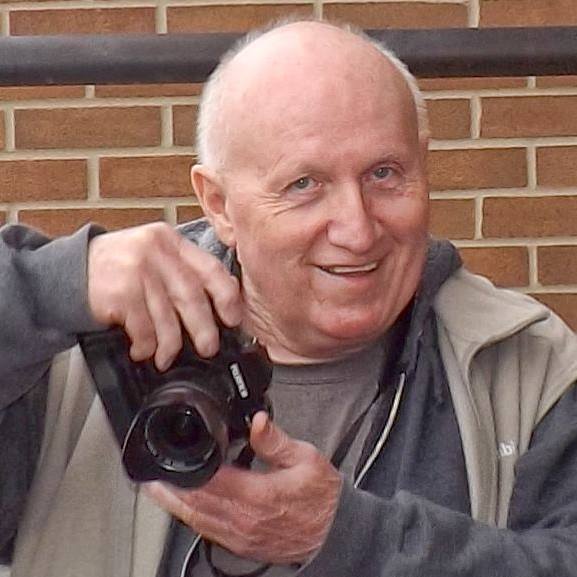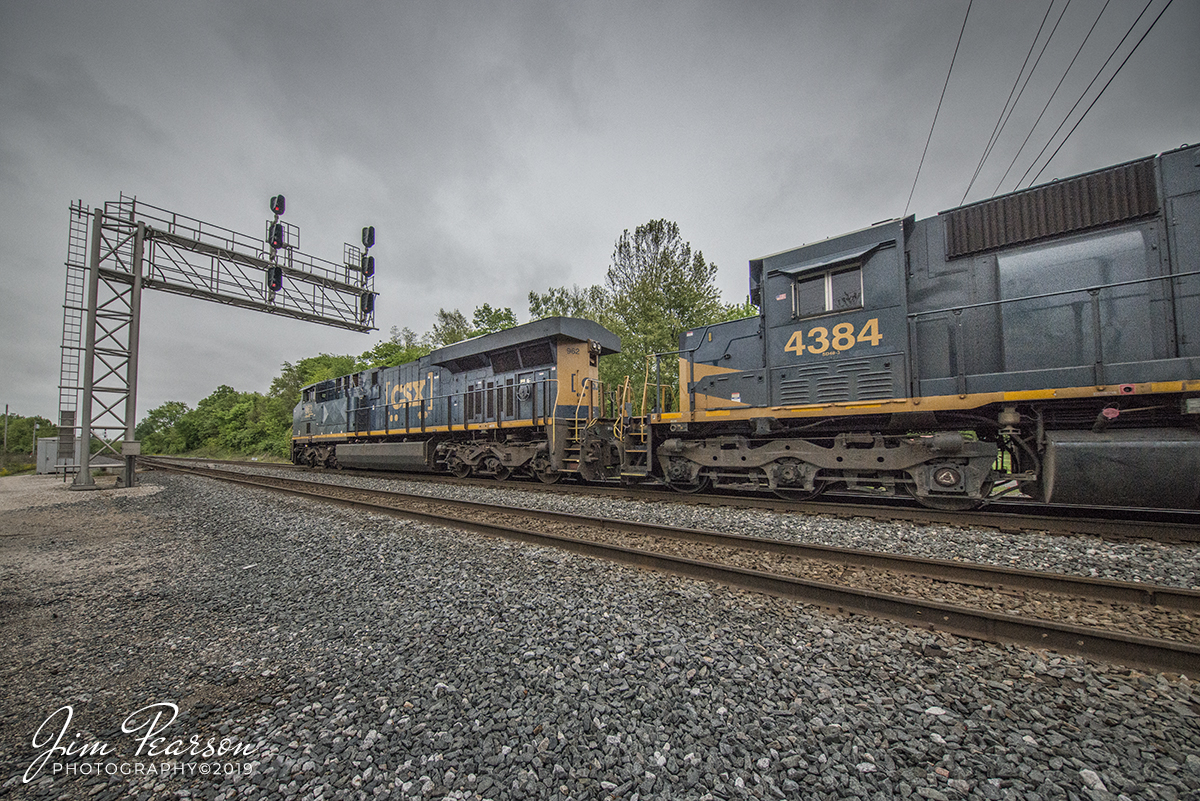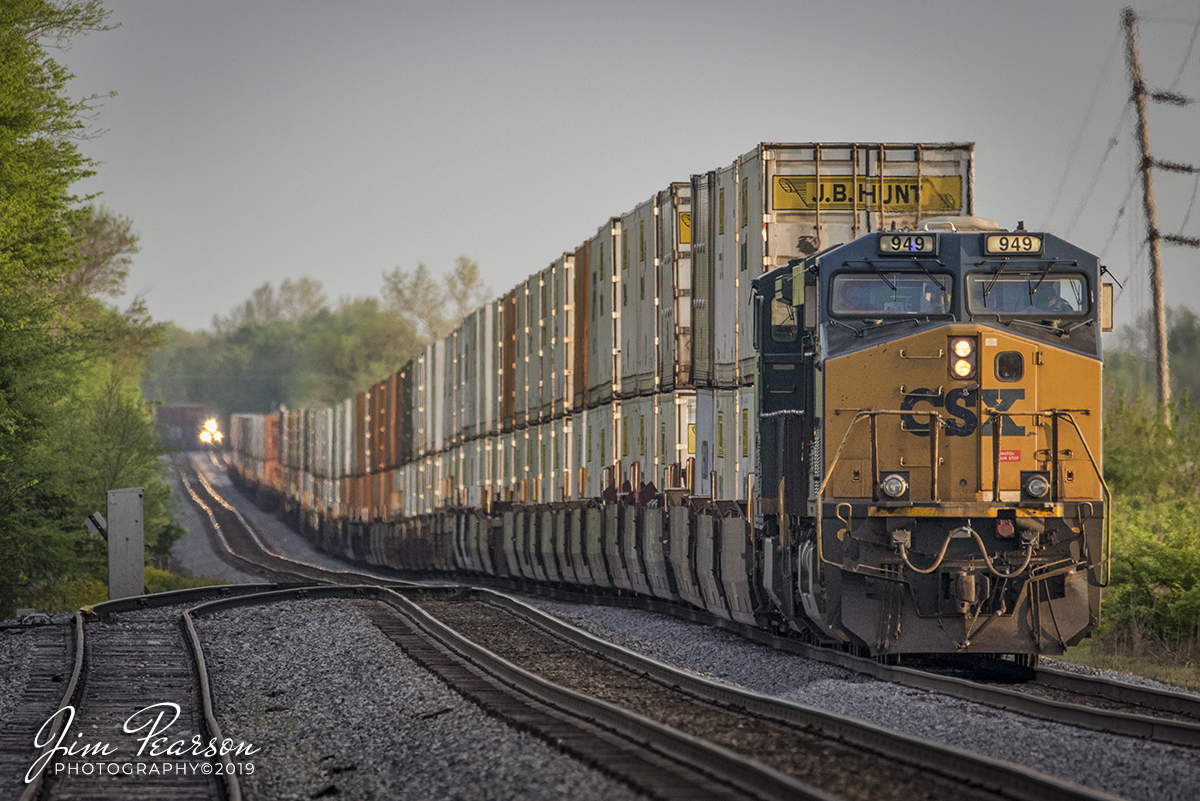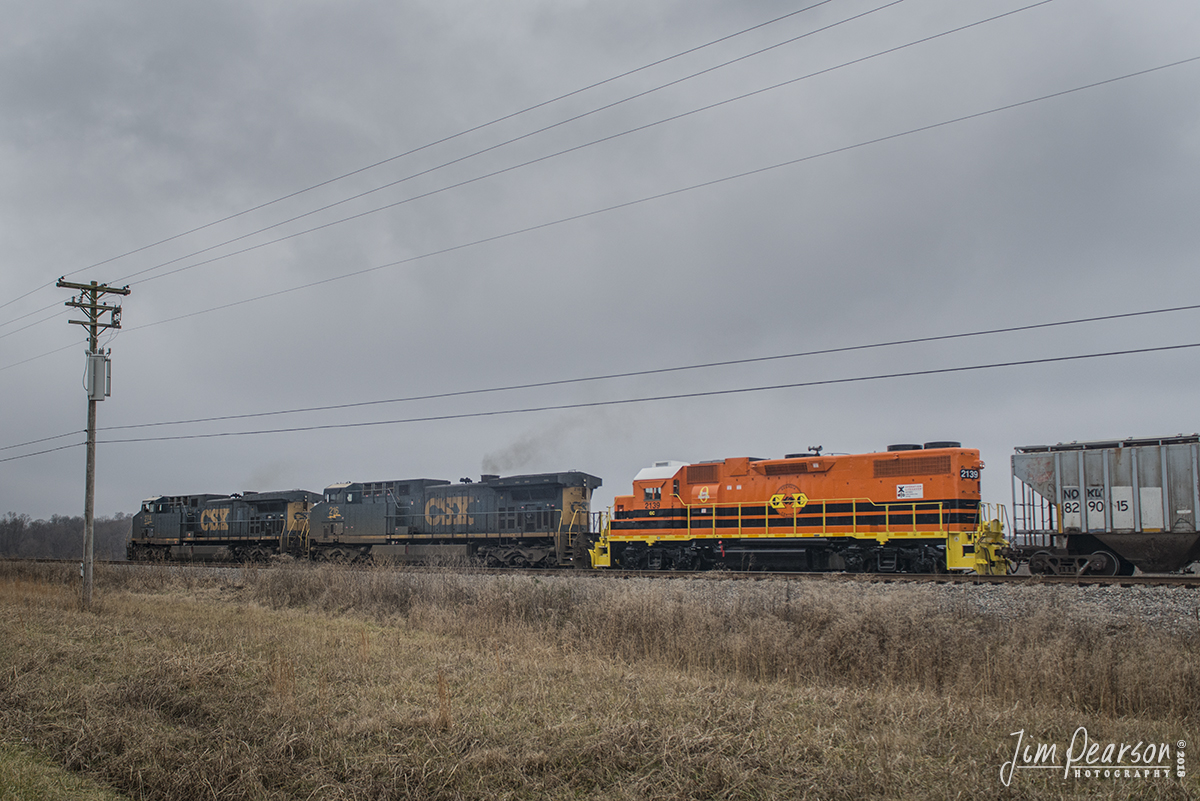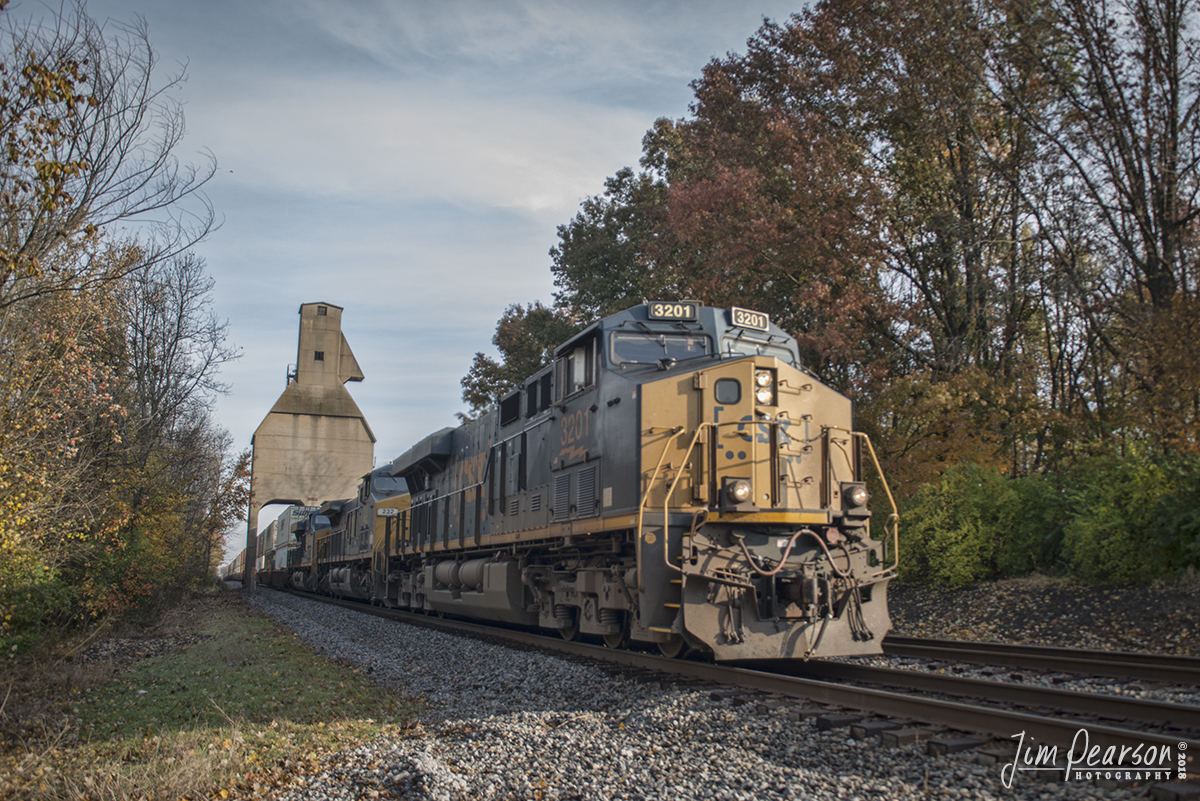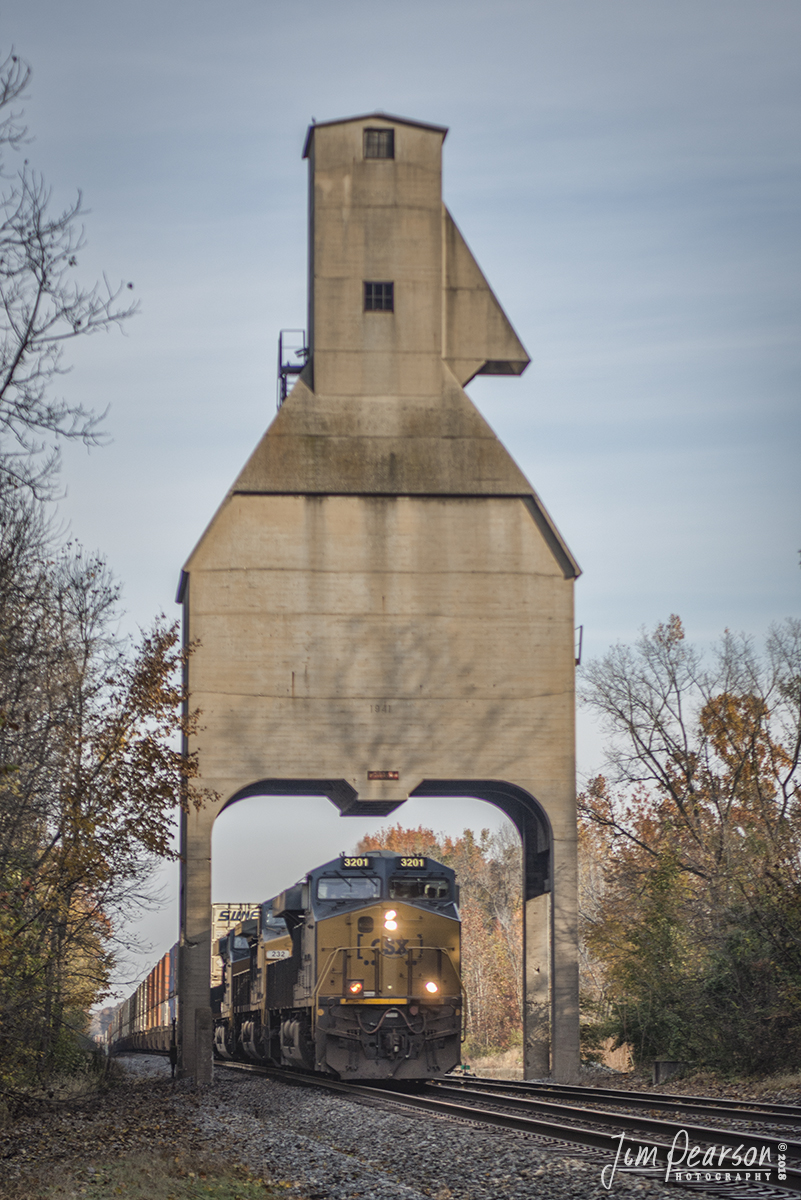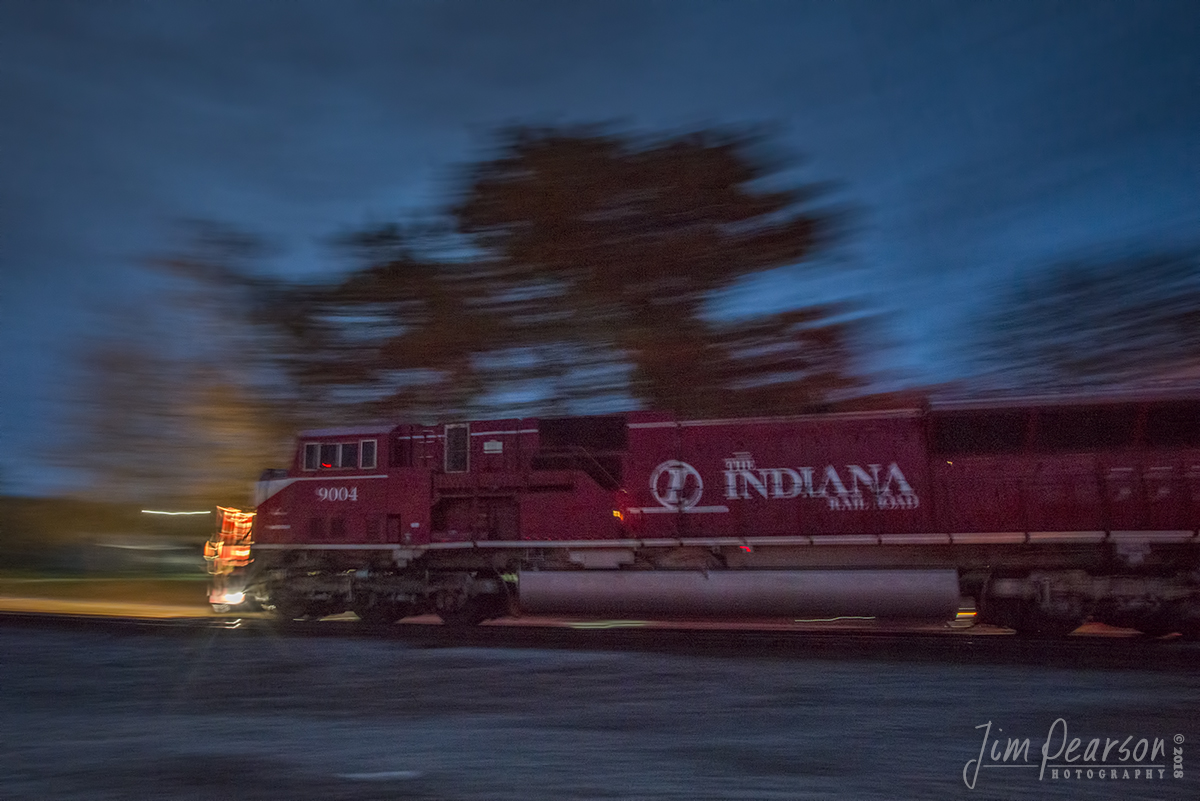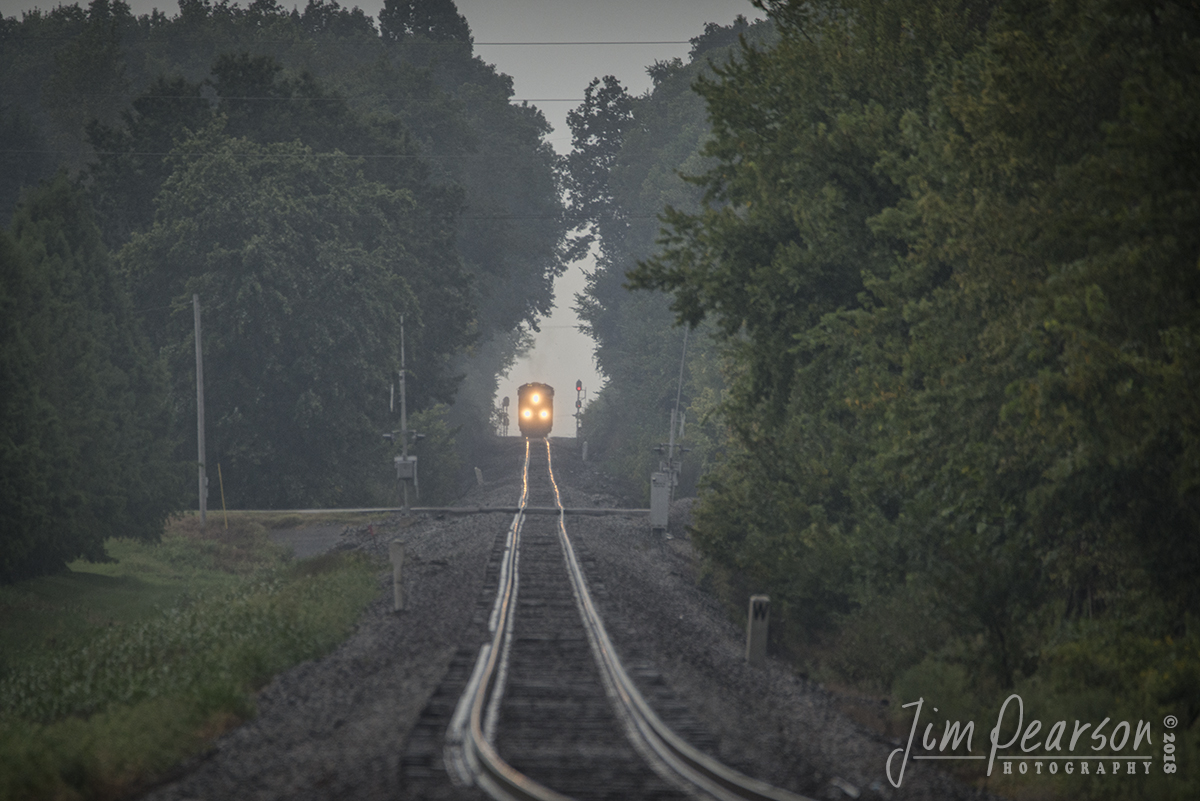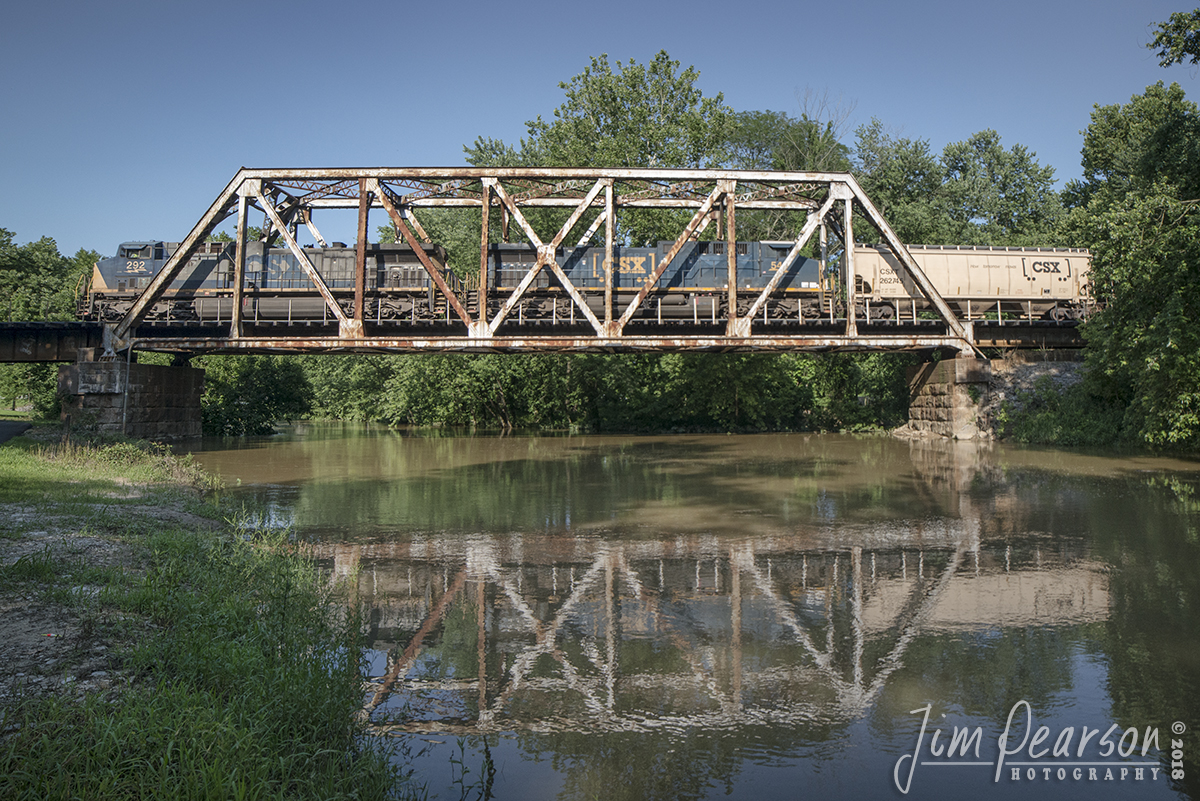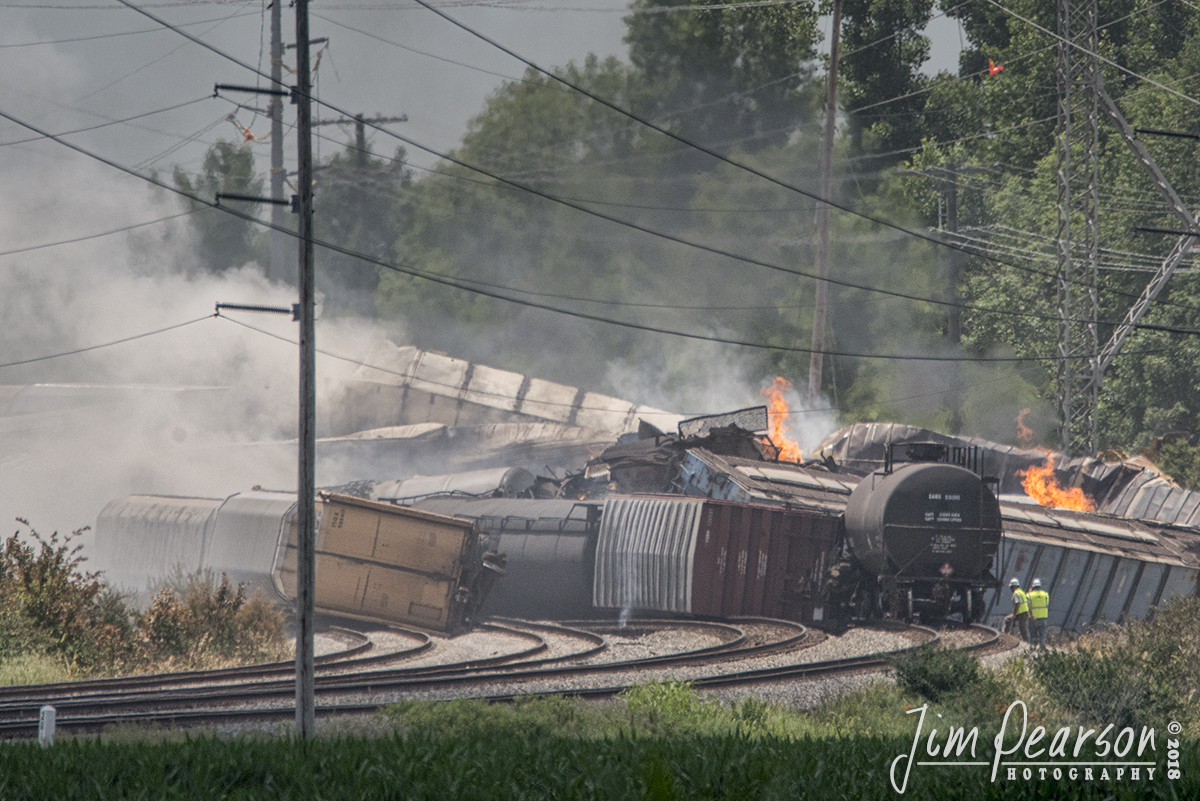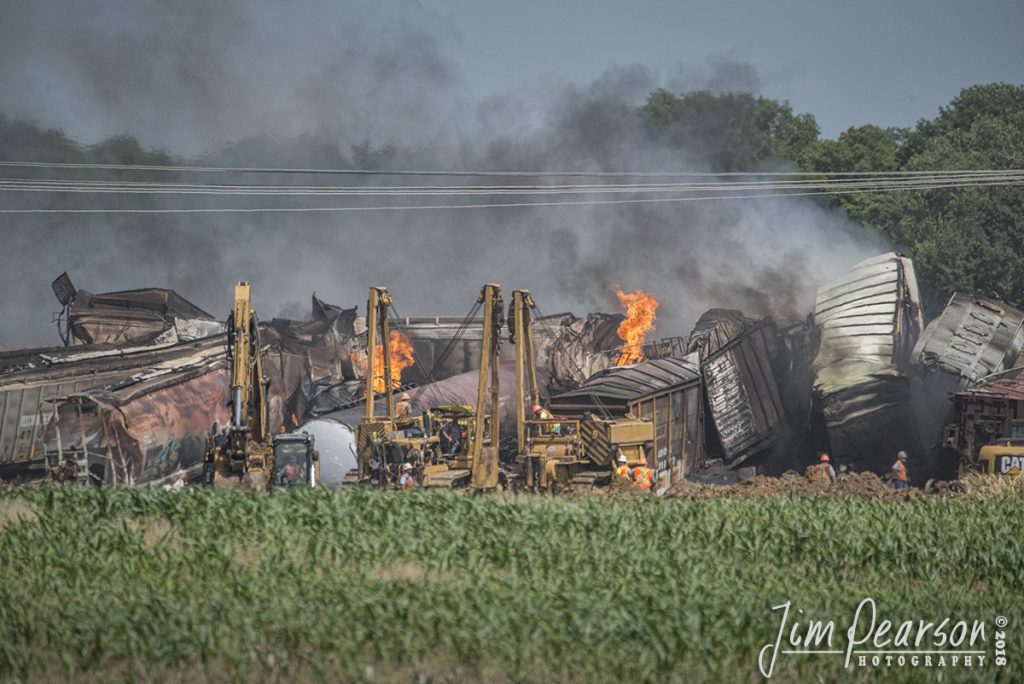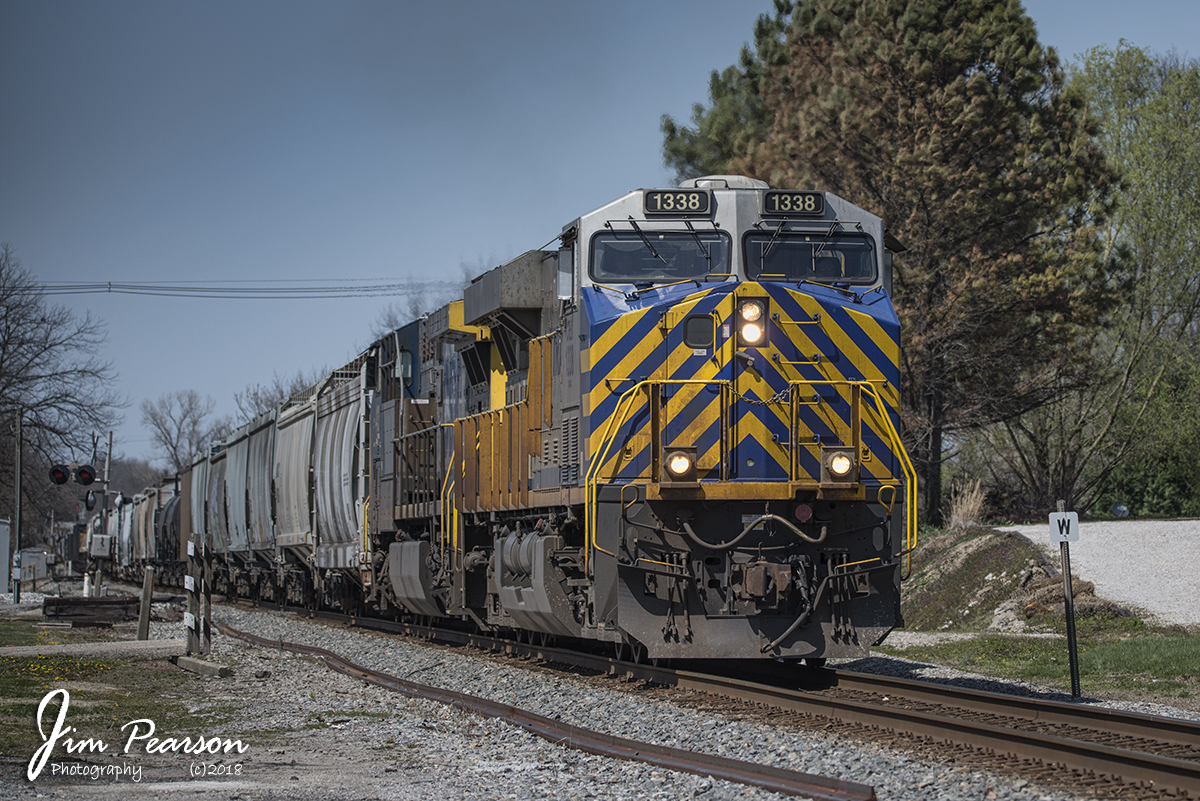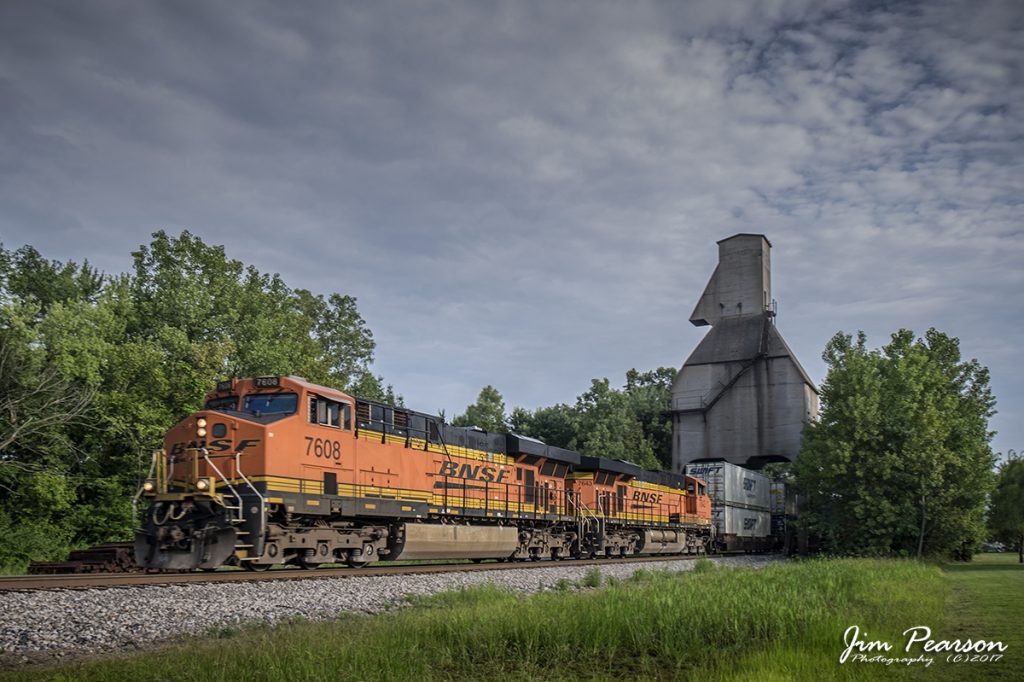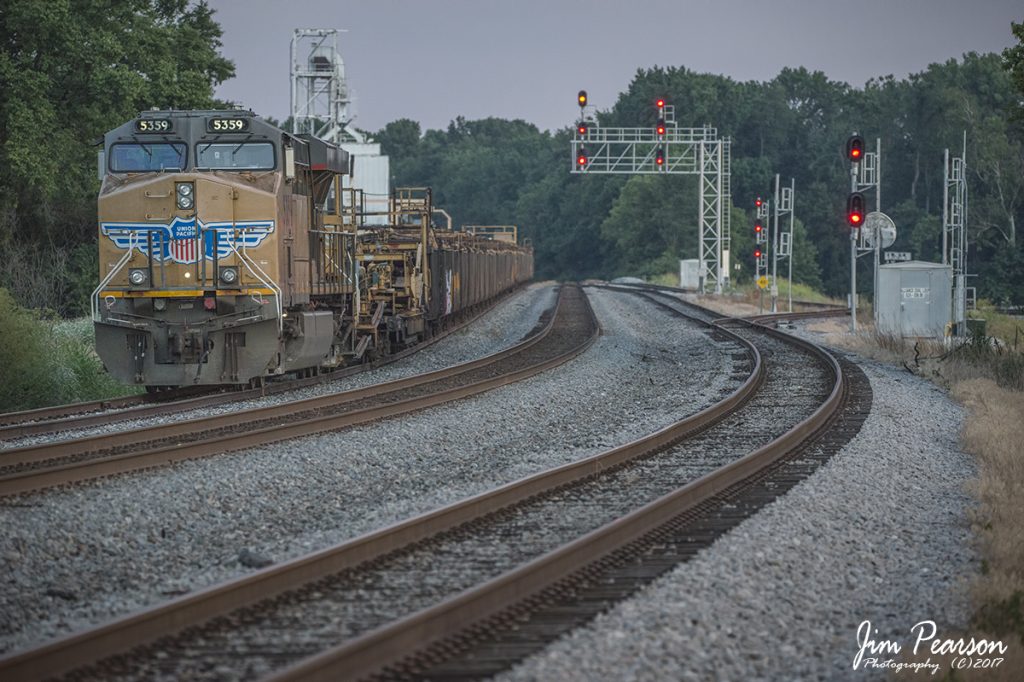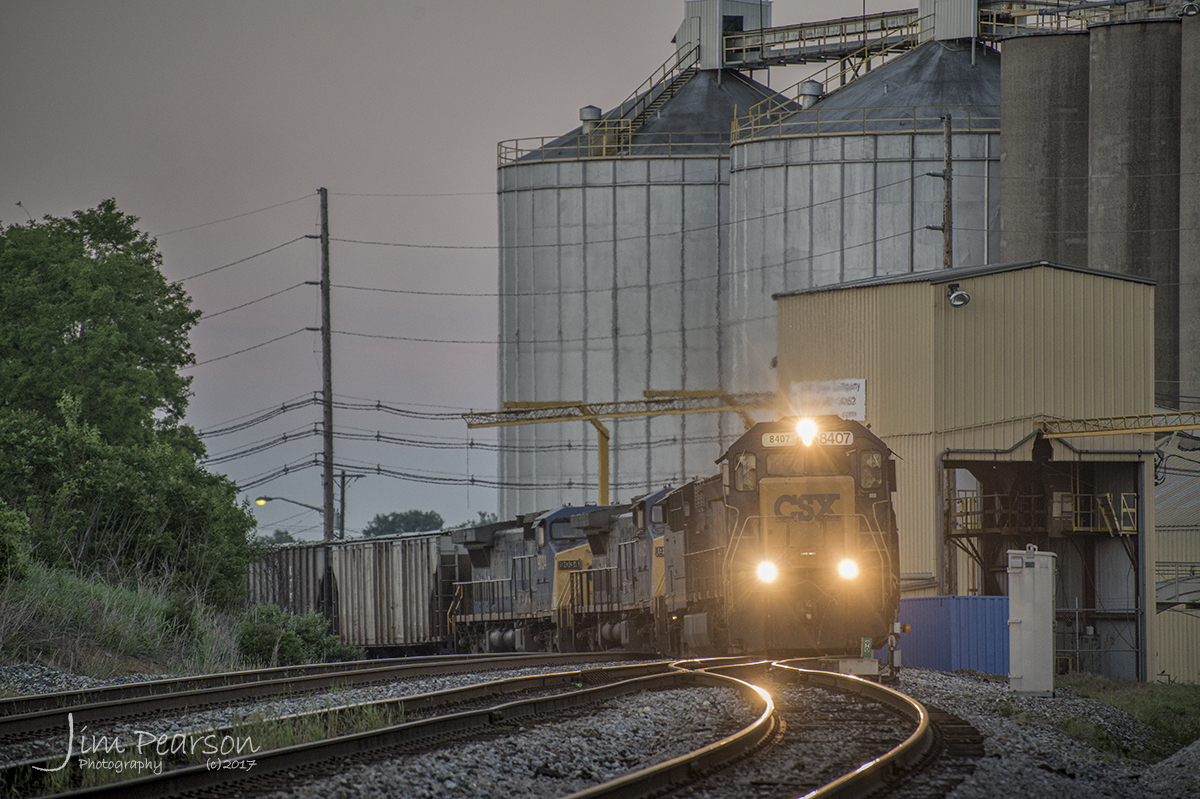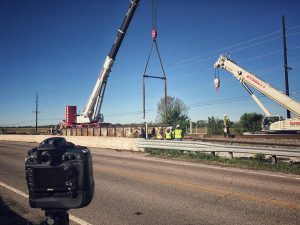May 4, 2019 – A northbound CSX Q512 passes the signals at at Middle King, at Princeton, Indiana on the CE&D Subdivision, with CSXT 4384 as the trailing unit that used to be referred to as the Clinchfield logo unit. I’m told It received the unauthorized yellow stripes and the word Clinchfield on the nose the night before the 74th Santa Train. CSX took the Clinchfield off the nose and the Clinchfield logo off the side but left the stripes.
The late evening sunlight sifts through…
April 27, 2019 – The late evening sunlight sifts through the intermodal containers on CSX Q028 as it and Q026 behind him, wait on a signal at King on track 1, at Princeton, Indiana so they can continue their trip north on the CE&D Subdivision. – #jimstrainphotos #indianarailroads #trains #nikond800 #railroad #railroads #train #railways #railway #csx #csxrailroad
January 1, 2019 – CSX Q513-01, with a brand new Genesee & Wyoming…
January 1, 2019 – CSX Q513-01, with a brand new Genesee & Wyoming motor third out, going to the Georgia Central Railway heads through the siding at Alliance as it heads south at Princeton, Indiana on the CE&D Subdivision.
According to Wikipedia: The Georgia Central Railway (reporting mark GC) operates about 174 miles (280 km) of former Seaboard Coast Line track from Macon, Georgia through Dublin, Georgia and Vidalia, Georgia to Savannah, Georgia. It also operates about 20 miles (32 km) of trackage between Savannah and Riceboro, Georgia, switching Interstate Paper LLC. It connects with CSX Transportation and the Norfolk Southern Railway. The Georgia Central Railway is owned by Rail Link, a subsidiary of Genesee & Wyoming Inc. – #jimstrainphotos #indianarailroads #trains #nikond800 #railroad #railroads #train #railways #railway #csx #csxrailroad
November 3, 2018 – Illuminated by the early morning sun, CSX Q029…
November 3, 2018 – Illuminated by the early morning sun, CSX Q029 (Chicago, IL – Atlanta, GA) heads south on CSXs CE&D Subdivision at Sullivan, Indiana, under the old C&EI coaling tower that was built in 1941 to service steam locomotives. – #jimstrainphotos #indianarailroads #trains #nikond800 #railroad #railroads #train #railways #railway #csx #csxrailroad
November 3, 2018 – Illuminated by the early morning sun, CSX Q029
November 3, 2018 – Illuminated by the early morning sun, CSX Q029 (Chicago, IL – Atlanta, GA) heads south on CSX’s CE&D Subdivision at Sullivan, Indiana, under the old C&EI coaling tower that was built in 1941 to service steam locomotives. – #jimstrainphotos #indianarailroads #trains #nikond800 #railroad #railroads #train #railways #railway #csx #csxrailroad
November 3, 2018 – Indiana Railroad 9004 leads Z464…
November 3, 2018 – Indiana Railroad 9004 leads Z464 as it pulls onto the CSX CE&D Subdivision’s Baker siding at Terre Haute, Indiana to perform interchange work with CSX as the last light of the day fades from the sky.
According to Wikipedia: The Indiana Rail Road (reporting mark INRD) is a United States Class II railroad, originally operating over former Illinois Central Railroad trackage from Newton, Illinois, to Indianapolis, Indiana, a distance of 155 miles. This line, now known as the Indiana Rail Road’s Indianapolis Subdivision, comprises most of the former IC line from Indianapolis to Effingham, Illinois; Illinois Central successor Canadian National Railway retains the portion from Newton to Effingham. INRD also owns a former Milwaukee Road line from Terre Haute, Indiana, to Burns City, Indiana (site of the Crane Naval Surface Warfare Center), with trackage rights extending to Chicago, Illinois. INRD serves Louisville, Kentucky, and the Port of Indiana on the Ohio River at Jeffersonville, Indiana, through a haulage agreement with the Louisville & Indiana Railroad (LIRC). – #jimstrainphotos #indianarailroads #trains #nikond800 #railroad #railroads #train #railways #railway #csx #csxrailroad #inrdrailroad #indianarailroad
September 12, 2018 – CSX Q501-12 pulls past the signals at the north end of Hybird…
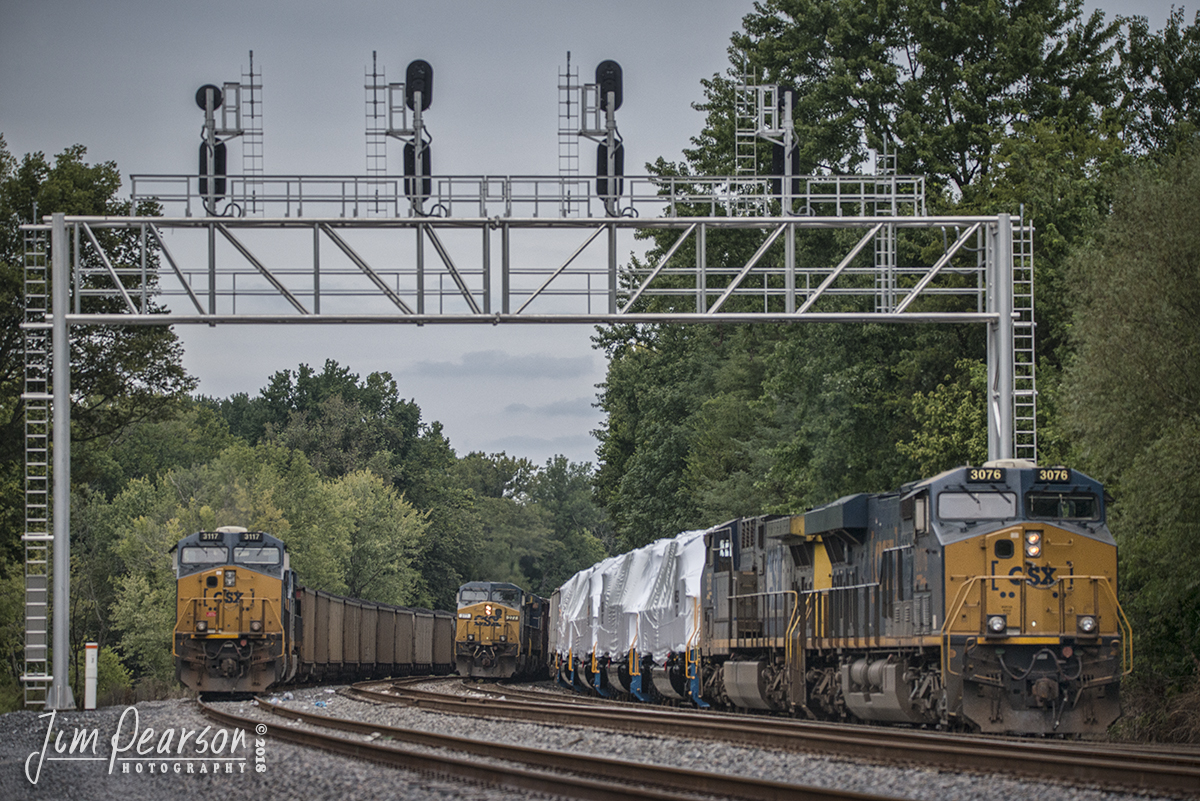
September 12, 2018 – CSX Q501-12 pulls past the signals at the north end of Hybird at Howell Yard in Evansville, Indiana with shrink wrapped NREX 122, 123, 124 & 125 trailing behind CSXT 3076 and 536 as it heads south on the Henderson Subdivision. Just four days later these NREX units ended up on the ground, between Peedee and Lilesville, NC after a derailment due to a washout from the rains from Hurricane Florence. Fortunately the engine carrying the crew (not the one pictured here) did not derail and they only suffered minor injuries.
From what I’m told the NREX Units that are Export SD40-3 rebuilds for Compagnie des Bauxites de Guinée, The Republic of Guinea, are all on the ground and are probably a total loss.- #jimstrainphotos #indianarailroads #trains #nikond800 #railroad #railroads #train #railways #railway #csx #csxrailroad
August 29, 2018 – CSX Q588 heads through St. James Curve at Johnson Township Indiana
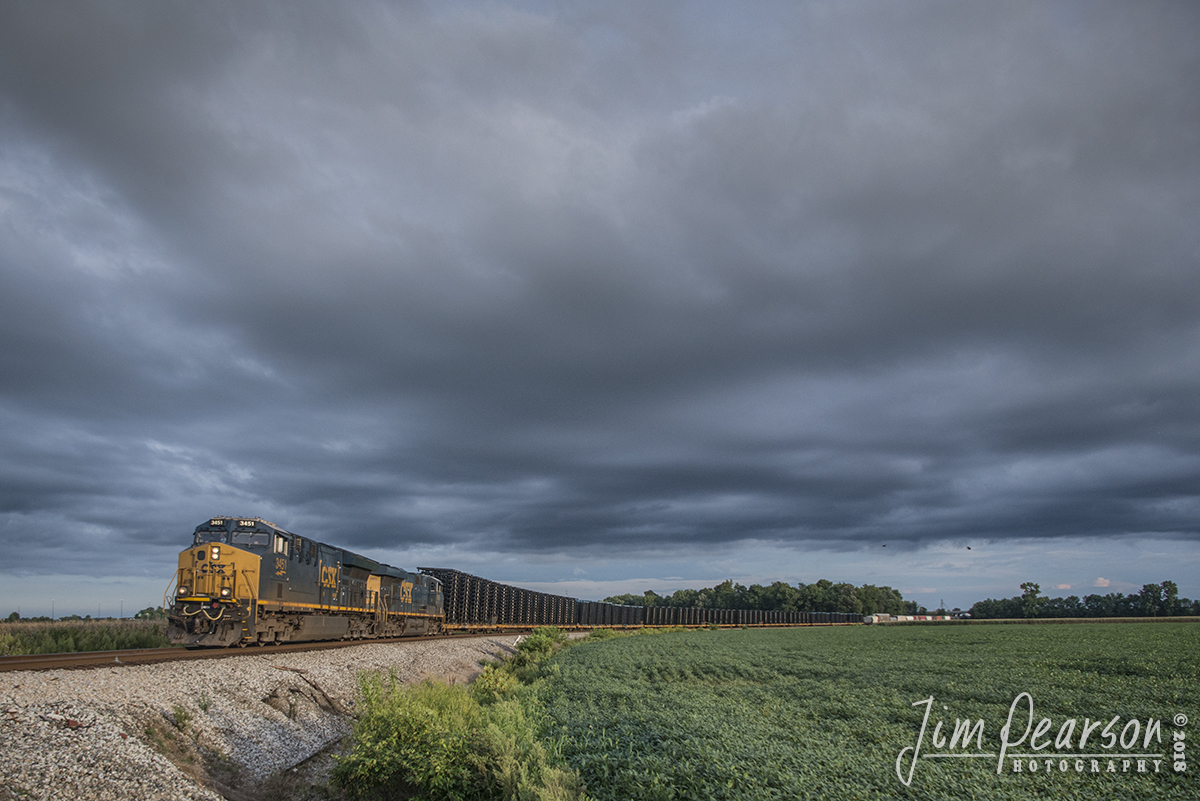
August 29, 2018 – CSX Q588 heads through St. James Curve at Johnson Township Indiana as a break in the stormy skies sends a shaft of light onto the train as it makes its way south on the CE&D Subdivision. – #jimstrainphotos #kentuckyrailroads #trains #nikond800 #railroad #railroads #train #railways #railway #csx #csxrailroad
August 29, 2018 – CSX local J721-29 passes the signals at Darmstadt, Indiana
June 15, 2017 – CSXT 292 is reflected in the Patoka river…
June 17, 2018 – CSX Derailment at Princeton, Indiana…
June 18, 2018 – Around 7pm CST Sunday, June 17th, a southbound CSX mixed freight, Q0513-17,(Avon, IN – Waycross, GA) derailed midway into it’s train just south of Princeton, Indiana on the CE&D Subdivision. The power for the train remained upright and the crew escaped without injury, according to reports. The initial thoughts are that the derailment was caused by a kink in the tracks due to the high heat, causing the train to derail close to the north end of King Siding, next to the Toyota tracks. The area was evacuated overnight tank cars, reportedly carrying propane burned off.
The derailment caused a major CSX route that includes the Henderson and CE&D Subdivisions to be out of service through the area, except for some local traffic. RJ Corman derailment and reportedly Hulcher services clean-up crews arrived early this morning and cleanup of the site is underway.
As of about 3pm CST the area was re-opened to residents and traffic. Just how long before the track is open to trains, remains unknown at this time. –#jimstrainphotos #indianarailroads #trains #nikond800 #railroad #railroads#train #railways #railway #csx #csxrailroad
CSX Q028-11 approaches SE of Harwood, Evansville, In
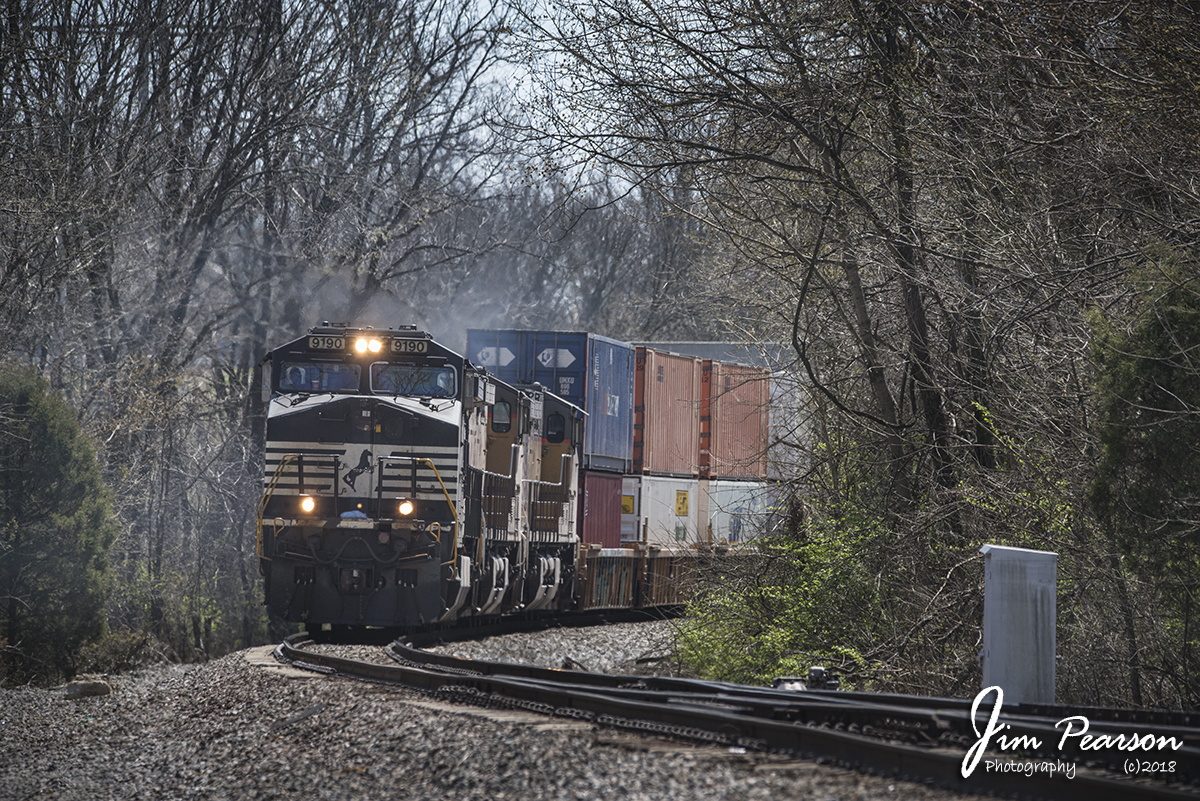
April 12, 2018 – Norfolk Southern 9091 and two Union Pacific engines head up CSX Q028-11 as it rounds the curve coming into the south end of Harwood on it’s way north up the CE&D Subdivision at Evansville, Indiana. – #jimstrainphotos #indianarailroads #trains #nikond800 #railroad #railroads #train #railways #railway #csx #csxrailroad #nsrailway #nsrailroad
CSX Q289 SB with CREX 1338 at Ft. Branch, In
CSX Q501-12 at the south end of Harwood in Evansville, Indiana
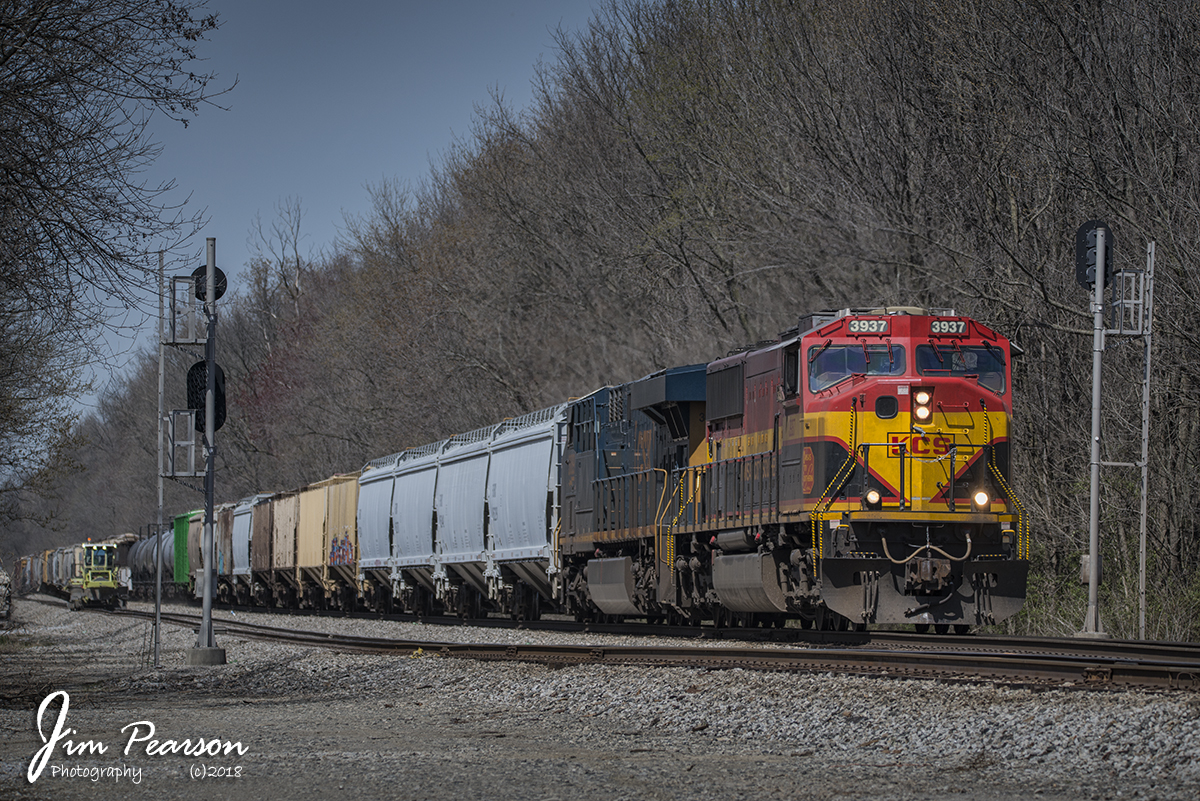
April 12, 2018 A new train, CSX Q501-12 (Chicago to Nashville), heads through the south end of Harwood at Evansville, Indiana with KCS 3937 leading the way as it heads south on the CE&D Subdivision. – #jimstrainphotos #kentuckyrailroads #trains #nikond800 #railroad #railroads #train #railways #railway #csx #csxrailroad
April 4, 2018 – CSXT 2785 with an American Flag waving on it’s hood, heads up local Y102-04 …
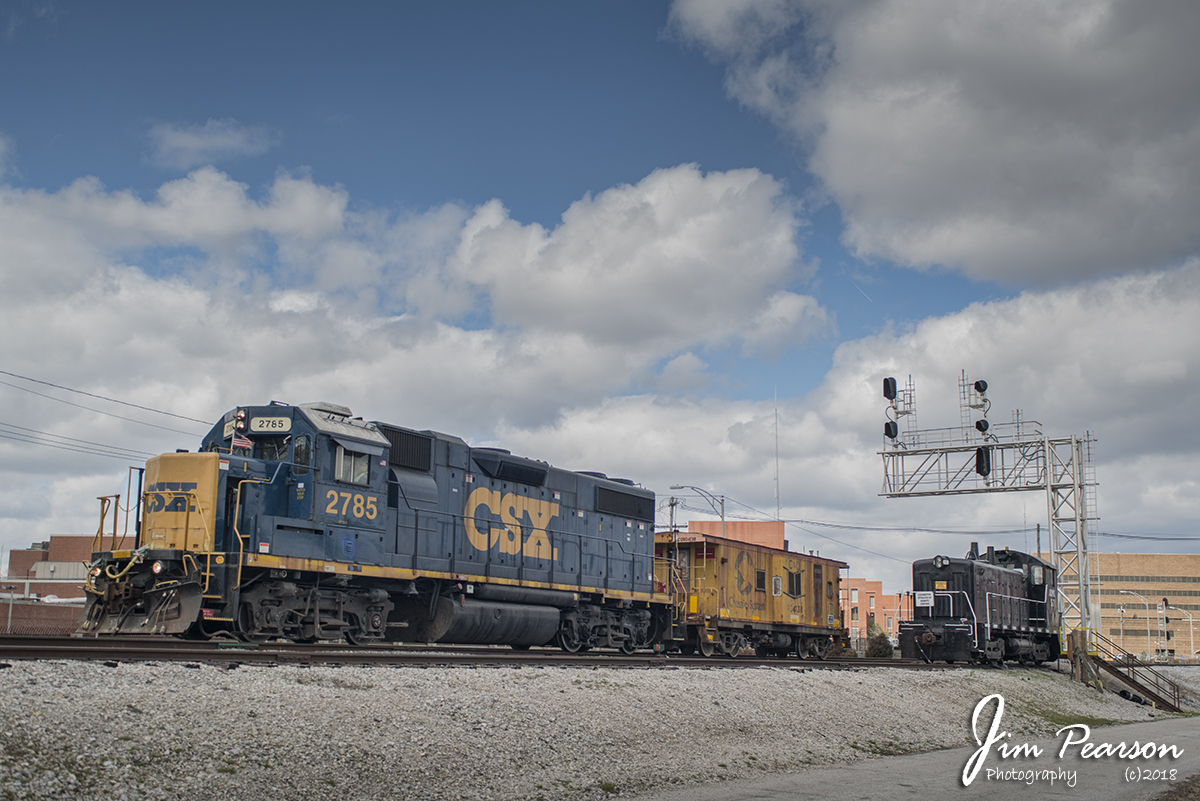
April 4, 2018 – CSXT 2785 with an American Flag waving on it’s hood, heads up local Y102-04 after passing ADMX 57, an EMD-built SW1200, originally Baltimore and Ohio (B&O) 9621, at the ADM facility as it makes it’s way south to Howell Yard in Evansville, Indiana with Chessie System Caboose 904138. – #jimstrainphotos #indianarailroads #trains #nikond800 #railroad #railroads #train #railways #railway #csx #csxrailroad
CSX Q645-15 heads south under the coaling tower at Sullivan, IN
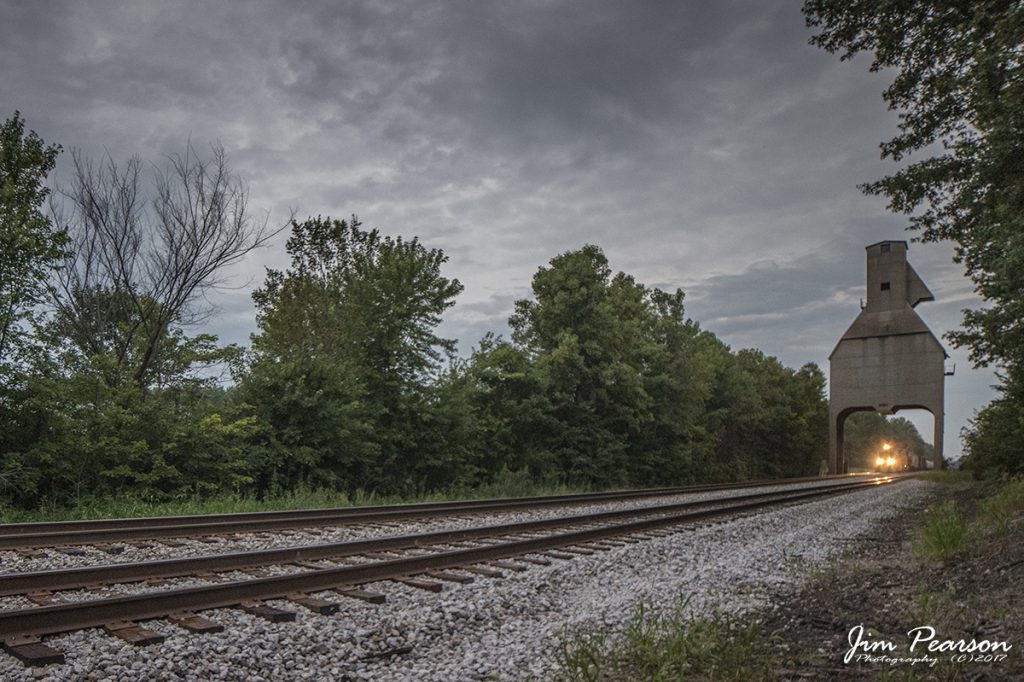
August 16, 2017 – Dusk falls as Union Pacific 4061 leads CSX Q645 (Chicago, IL-Waycross, GA), south underneath the old C&EI coaling tower that was built in 1941 to service steam locomotives, as it headed south on CSX’s CE&D Subdivision at Sullivan, Indiana! Of the three CSX trains I caught under this tower today and the only one of the trains that ran with CSX power and it was trailing.
CSX Q028-16 northbound at Sullivan, Indiana
August 16, 2017 – BNSF 7608 and 7643 were a great surprise when I found them leading CSX Q028-16 as it popped out underneath the old coaling tower as it headed north on CSX’s CE&D Subdivision at Sullivan, Indiana!
Good friend and fellow railfan Ryan Scott and I headed up to this spot late in the afternoon hoping to catch some traffic under this tower that was built in 1941 to service steam locomotives with coal during their runs. Another friend, Ryan Collins had posted a picture from here earlier in the week and I knew I wanted to catch a few photos from here so I made the two hour trip north and picked up Ryan along the way.
When we got there we were listening to the scanner and became concerned that we wouldn’t get much before it got dark because Q645 had broken a knuckle and went into emergency a bit further to the north and they didn’t have one on their engine. Plus Q101 was behind them and we knew 28 was heading toward them.
Both the southbounds were in a siding and Q028 had a knuckle on their train so they pulled on up to where the conductor on 645 was waiting and dropped off the knuckle. Of course they had to replace the knuckle and make sure all the cars on their 10,000+ foot train were still upright before 28 could continue past them.
I thought sure we weren’t going to catch any southbounds before we lost all of our light at the coaling tower, but we were fortunate that the railfan God shined upon us and we caught both of them before it got too dark! I’ll post the other two photos over the next few days!
We also were fortunate enough to catch some Indiana Railroad action while we were waiting as well! Those will be coming over the next few days as well! A totally great afternoon/evening trackside!!!
CSX rail train tied down at Princeton, In
CSX Q645 rounds a curve as it approaches Howell Yard, Evansville, Indiana
CSX 573 heads up CSX Q648-17 at Patoka, IN on the CE&D Subdivision.
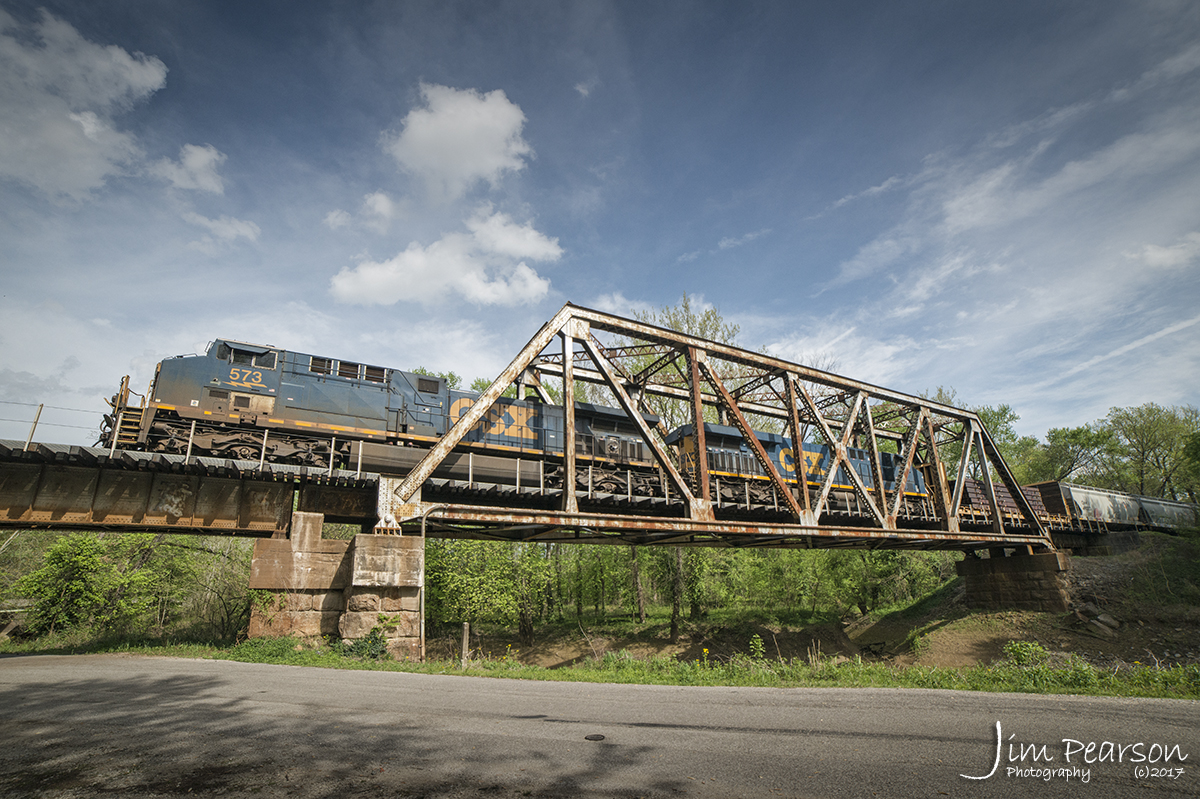
April 19, 2017 – Despite it being a hot muggy day, with way too many gnats buzzing around, we found a parade of north bounds making their way up CSX’s CE&D subdivision across the Patoka River box bridge at Patoka, Indiana. Here CSXT 573 heads up CSX Q648-17 (Waycross, GA – Chicago, IL) as it makes it’s way north on the CE&D Subdivision.
Tips on shooting a time-lapse railroad video by Jim Pearson
In this post I’ll be talking about some of the many options available for shooting time-lapse videos of railroads, or any subject matter.
Time-lapse photography is a technique whereby the frequency at which film frames are captured (the frame rate) is much lower than that used to view the sequence. When played at normal speed, time appears to be moving faster and thus lapsing. For example, an image of a scene may be captured once every second, then played back at 30 frames per second; the result is an apparent 30 times speed increase. Time-lapse photography can be considered the opposite of high speed photography or slow motion.
Processes that would normally appear subtle to the human eye, e.g. the motion of the sun and stars in the sky, become very pronounced. Time-lapse is the extreme version of the cinematography technique of undercranking, and can be confused with stop motion animation.
Here is my most recent time-lapse video of CSX crews changing out a bridge in Ft. Branch, Indiana.
I use a Nikon D800 full frame camera when shooting my time-lapses. While many cameras, including an iPhone, are capable of doing this, my post will center around how I do mine using my equipment. At the end of the post I’ll list some other options available and by no means will this post or list be all inclusive. The above video was shot using a Nikkor 18mm a f/8 at an interval of 1 second.
I like using the D800 for doing time-lapse because when it’s finished shooting the camera combines all the individual frames together in the camera and saves them as a video instead of individual JPG or RAW files. So far I’ve only shot using JPG Fine because of file sizes and storage on my Compact Flash Card.
Plan Ahead – Think and plan ahead on how you’re going to do your time lapse and pick a good subject that will have plenty of action! It’s not a good idea to arrive 5 minutes before the action starts! Also, if you’re going to have to shoot on private property then you’ll need to obtain permission first. If it’s from public access then it’s not as big a problem. Above all else when photographing around trains or other heavy equipment you need to always be aware of your surroundings, stay safe and never trespass!
Don’t Forget Anything – When shooting time-lapse you can spend several hours standing by the side of the road out in the boonies so it’s good to be prepared! Not to sound like your mom, but you should take enough water and food. If it’s winter or foul weather then spare socks, shoes, warm coat and gloves. In summer, more water, a hat and sunscreen are must haves! A fully charged cell phone and something to read will help pass the time as well. Of course, it goes without saying your camera and tripod and all the batteries you can carry for your camera.
Batteries – Shooting a time-lapse will drain your batteries quickly so always take spares! If you shoot in 1 second intervals then that’s 60 photos a minute. Multiply that by an hour (gives you 30 seconds of video at a frame rate of 30 FPS) and you’re shooting 3,600 photos an hour! If you only have two batteries then consider taking your battery charger along and charging your spare battery in the car. The key is to keep the camera shooting pictures and if you run out of juice then your time-lapse will suffer for it.
Tripod – You need a good sturdy tripod! If you only have a lightweight one then consider attaching a weight to the center pole in order to give it more stability. If the camera moves or shakes between exposure it can result in a shaky video. This is extremely important if your shutter speed is on the slow side because of the lower light levels, which can make for some interesting blur effects.
Exposure Mode – Whatever camera you use, set it to manual mode. Any other mode where the camera controls and changes the aperture or shutter speed, the camera will try to correct every change of light and color temperature, which can result in a flicker in your video. “Flicker” is known as the unwanted effect that occurs in the “time-lapse” due to slight differences in exposure between shots.
Focusing – I suggest turning off the autofocus and doing so manually instead. While the time-lapse is exposing it shouldn’t cause a problem as long as you don’t touch the shutter button on your camera, but it’s better to be safe than sorry. You can use autofocus to focus once you have your framing setup and then turn it off during your time-lapse sequence. Don’t forget to refocus when you change your camera position.
Shutter Speed – I tend to keep my shutter speed a bit high, but here again it all depends on the light and time of day. If you’re shooting late in the evening or at night then you may have to use a slower shutter speed. When doing so keep in mind that if you’re shooting at 1 second intervals that with a 10 second exposure (low light photography) it’s going to take more than 1 second interval to record your file to your card. You may have to adjust accordingly.
Aperture and Exposure – All lenses have a sweet spot (it’s sharpest point). I find that 2-3 stops from your widest aperture is the best. If shooting with a f/2.8 lens then that would be at f/8. Be sure to watch your exposure throughout the day and make sure it’s consistent. The sun move and exposure changes so to make sure it’s even throughout check it every time you change the camera’s position or at least once an hour, is my rule of thumb.
Lens – This all depends on your preference. Sometimes I’ll use a 24-70 so I have the option to zoom in on different aspects of the scene without changing lenses. On the time-lapse above I used a 18mm at f/8.
Time Lapse Duration – I personally prefer having the camera shoot a photo in the 1-2 frames a second range. The CSX bridge change video was shot at 1 second intervals.
To make your time-lapse a bit more interesting visually it’s best to stop the time-lapse and re-position the camera every so often to help give more visual impact.
 A good app and the one I use to figure out my interval is called PhotoPhills. It runs $9.99 in the app store, but is well worth it and does a lot more than the time-lapse calculations. Click here for their website.
A good app and the one I use to figure out my interval is called PhotoPhills. It runs $9.99 in the app store, but is well worth it and does a lot more than the time-lapse calculations. Click here for their website.
The app will help you figure out how often you need to expose, how long and how much room you’ll need on your card to store all the information that you capture. If your camera doesn’t combine everything together in the end to make your video your card may require a lot of space to store the thousands of JPGs or RAW files. Here’s a link to an online version of their Time-lapse Calculator you can use for free.
If your camera doesn’t combine your JPGs or RAW files then you’ll need to look for a program to combine all the resulting files into a video clip that you can edit. There are several programs available to do this, some of which are listed below.
One of the most popular is LRTimelapse. A few others are: GBTimelapse, Time-Lapse Tool and Panolapse. There is many more and to find them just do a Google search.
Here’s a good article on how to shoot time-lapse using your iPhone or iPad. There’s many other apps for doing this with your smart device. Just search your phone’s app store. How to Take Amazing iPhone Time Lapse Videos
To give my time-lapse the polished look complete with titles and transitions I use Adobe Premiere Pro CC, the online version. It’s available for a subscription fee of $19.99 a month. There’s many other programs available to edit video however and most all do a good job.
There is so much more to shooting time-lapse, but I hope this post will at least give you a good starting point and food for thought!
